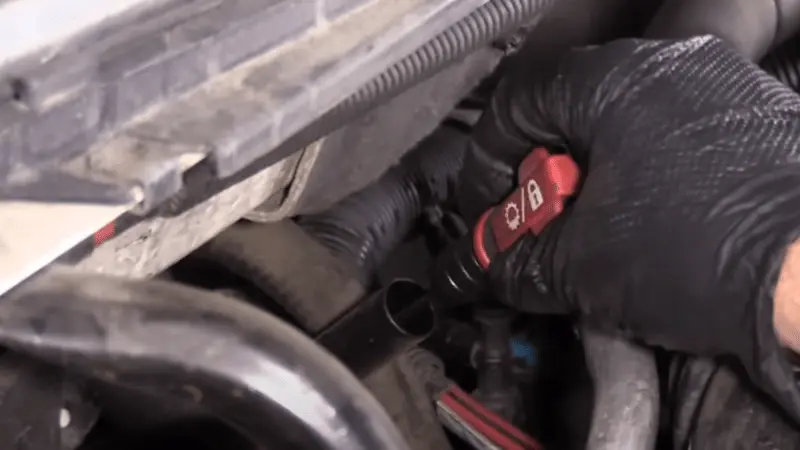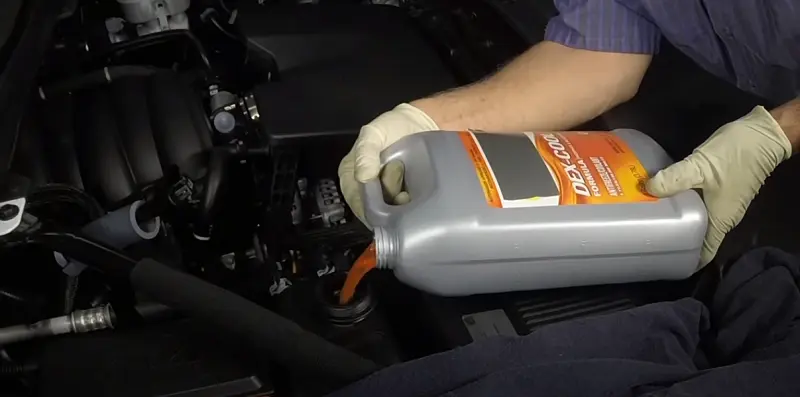Your Chevy Silverado is a workhorse known for its reliability and power. To keep it running smoothly, one often overlooked aspect of maintenance is checking the transmission fluid. A well-maintained transmission ensures that your truck shifts gear effortlessly, improving performance and longevity.
In our blog post, we’ll walk you through a simple yet crucial task on “How To Check Transmission Fluid Chevy Silverado.” Get ready to empower yourself with the knowledge needed to keep your Silverado’s transmission in top condition.
How To Check Transmission Fluid Chevy Silverado?

Regularly checking your vehicle’s transmission fluid is essential for maintaining the health and performance of your Chevy Silverado. This task ensures that the transmission system is adequately lubricated, preventing wear and tear and facilitating smooth gear changes.
Step 1: Gather Your Materials
Before you start, gather the necessary materials. You’ll need a cloth, a funnel, and, if required, additional transmission fluid that is compatible with your Silverado’s specifications. Having these items on hand will help ensure a smooth and efficient inspection.
Step 2: Warm Up the Engine
To get an accurate reading, it’s important to warm up the transmission fluid. Start your Chevy Silverado’s engine and let it run for a few minutes. This allows the fluid to reach its operating temperature, providing a more accurate measurement. Before proceeding, ensure that the vehicle is in the “Park” position and that the engine is turned off.
Step 3: Locate the Dipstick
The transmission fluid dipstick’s location may vary depending on your Silverado’s model year and configuration. For front-wheel drive vehicles, the transmission fluid dipstick is typically located to the right of the oil dipstick. If you need help finding it, consult your vehicle’s owner’s manual for guidance.
Step 4: Check the Fluid’s Color

Once you’ve located the transmission fluid dipstick, it’s time to assess the fluid’s condition. Carefully remove the dipstick from its holder and use your forefinger to extract a small amount of fluid. Roll the fluid between your thumb and index finger, and pay attention to its color. The ideal transmission fluid color is a transparent pink or reddish hue. If you notice that the fluid is muddy or has a burnt smell, it’s an indication that a replacement is necessary. In such cases, it’s advisable to visit a professional repair provider for a thorough inspection and fluid replacement.
Step 5: Clean the Dipstick
After inspecting the transmission fluid, use a clean cloth to wipe the dipstick clean. This ensures that no contaminants or residue interfere with your next assessment.
Step 6: Check the Fluid Level
With the dipstick cleaned, reinsert it into the tube. Make sure it’s properly seated. Then, pull it out again to check the fluid level. The dipstick usually has two indicators, “Full” and “Add.” The fluid level should ideally be close to the “Full” marker. If the transmission fluid is below this indicator, it’s necessary to add more fluid to bring it to the appropriate level.
Step 7: Add Transmission Fluid (if required)
If your inspection reveals that the fluid level is below the “Full” indicator, it’s essential to add more transmission fluid to the reservoir. To ensure the correct type of fluid:
- Consult your Chevy Silverado’s owner’s manual.
- Once you’ve confirmed the fluid type, use a funnel to pour the fluid into the transmission fluid filler tube carefully.
- Take your time and avoid overfilling, as an excess of fluid can be as problematic as having too little.
RELATED: Interpreting 2014 Silverado Transmission Fluid Capacity
How to Know When to Check Your Transmission Fluid?

Transmission fluid is a vital component in your vehicle’s performance, and while it doesn’t require as frequent attention as engine oil, keeping it in good condition is essential. Knowing when to check your transmission fluid can help prevent issues and ensure a smooth ride. Here’s how to determine when to perform this crucial task:
1. Unusual Sounds and Gear Shifting:
Pay attention to your vehicle’s performance. If you hear jarring sounds when you press the accelerator, experience intermittent gear shifts, or notice a revving noise while taking corners, these may be signs of low or contaminated transmission fluid.
RELATED: Chevy Silverado Gear Shifter Not Working
2. Delayed Shifting:
If you feel a delay in the transmission’s response when shifting gears, it’s an indicator that your transmission fluid may need attention.
3. Routine Maintenance Schedule:
Consult your vehicle’s owner’s manual for the manufacturer’s recommended maintenance intervals. Regular transmission fluid checks and replacements, including transmission flushes, may be part of the prescribed maintenance schedule.
4. DIY Fluid Check:
To ensure your transmission has clean lubricant, you can perform a quick and straightforward check at home. Follow the manufacturer’s guidelines for the correct procedure. If you find issues with the fluid’s color, smell, or level, it’s time for a closer inspection and, if necessary, a fluid replacement.
How Often Should You Check The Transmission Fluid?

Checking your vehicle’s transmission fluid is an essential part of routine maintenance, and the frequency of these checks can significantly impact the health and performance of your vehicle. Here are some general guidelines for how often you should check your transmission fluid:
- Regular Inspections: It’s a good practice to check your transmission fluid regularly, especially if you drive an older vehicle or one with a history of transmission issues. Checking it every month or two can help you detect any early signs of a problem.
- Every Oil Change: Many vehicle manufacturers recommend checking the transmission fluid at every oil change, which is typically every 3,000 to 5,000 miles (4,800 to 8,000 kilometers). This provides a regular opportunity to assess the fluid’s condition.
- Refer to the Owner’s Manual: The most reliable advice on how often to check your transmission fluid comes from your vehicle’s owner’s manual. Different car models may have varying requirements, so always consult the manual for manufacturer-specific recommendations.
- Severe Driving Conditions: If you frequently operate your vehicle in severe conditions, such as heavy traffic, towing heavy loads, or driving in extreme heat, you may need to check the transmission fluid more frequently. These conditions can place additional stress on the transmission.
- Monitor for Warning Signs: In addition to scheduled checks, pay attention to warning signs that may indicate transmission issues, such as slipping gears, delayed or rough shifting, or unusual noises. If you notice any of these symptoms, it’s essential to inspect the transmission fluid promptly.
When To Replace The Fluid Of Chevy Silverado?

Replacing the transmission fluid in your Chevy Silverado is a crucial maintenance task that helps ensure the longevity and smooth operation of your vehicle’s transmission. The timing of fluid replacement can vary depending on the specific model, year, and usage of your Silverado. Here are some general guidelines for when to replace the transmission fluid:
- Refer to the Owner’s Manual: The most accurate guidance on when to replace the transmission fluid in your Chevy Silverado can be found in the vehicle’s owner’s manual. Different models and years may have specific recommendations, so always consult the manual for manufacturer-approved intervals.
- Regular Maintenance Schedule: Many manufacturers recommend replacing the transmission fluid every 30,000 to 60,000 miles (48,000 to 96,000 kilometers) as part of a regular maintenance schedule. This interval is a general guideline and can vary based on the type of transmission and the driving conditions.
- Severe Driving Conditions: If you frequently operate your Silverado in severe conditions, such as towing heavy loads, driving in stop-and-go traffic, or extreme heat, you may need to replace the transmission fluid more often. These conditions can place additional stress on the transmission.
- Fluid Condition: In addition to mileage or time-based intervals, it’s essential to monitor the condition of the transmission fluid. If you notice that the fluid appears discolored, has a burnt odor, or contains debris, it’s a sign that a replacement is necessary. Such symptoms may indicate transmission problems.
- Transmission Issues: If you experience transmission problems, such as slipping gears, rough or delayed shifting, or unusual noises, it’s crucial to have the transmission fluid replaced promptly. These issues can be exacerbated by old or degraded fluid.
- Complete Transmission Service: Some experts recommend a complete transmission service, which includes a fluid replacement, filter change (if applicable), and a thorough inspection every 30,000 to 60,000 miles (48,000 to 96,000 kilometers). This comprehensive service helps maintain the transmission’s health.
Frequently Asked Questions
1. What Should I Look For When Checking The Transmission Fluid Color In My Silverado?
When checking the transmission fluid, look for a transparent pink or reddish hue. This is the ideal color for healthy transmission fluid. If you notice that the fluid is muddy or has a burnt odor, it’s a sign that a replacement is necessary.
2. Can I Check The Transmission Fluid When The Engine Is Running?
No, it’s not recommended to check the transmission fluid with the engine running. Ensure that the engine is turned off and the vehicle is in “Park” before performing the check to get an accurate reading.
3. What If I Can’t Find The Transmission Fluid Dipstick In My Chevy Silverado?
The location of the transmission fluid dipstick may vary based on your Silverado’s model year and configuration. If you have trouble locating it, consult your vehicle’s owner’s manual for guidance on its precise location.
4. How Do I Add More Transmission Fluid To My Chevy Silverado If It’s Low?
If your inspection reveals that the transmission fluid level is below the “Full” indicator on the dipstick, you can add more fluid. Ensure you have the correct transmission fluid type, consult your owner’s manual, and use a funnel to add the fluid to the appropriate level carefully. Avoid overfilling, as this can cause issues.
Final Words
In the world of vehicle maintenance, checking your transmission fluid is often an overlooked but crucial task, particularly for Chevy Silverado owners. Our comprehensive guide on “How to Check Transmission Fluid Chevy Silverado” provides you with the knowledge and steps needed to keep your truck running at its best.
Regular inspections, especially in older or frequently used vehicles, can help detect issues before they become costly problems. By paying attention to your Silverado’s performance, fluid color, and adherence to manufacturer recommendations, you can ensure the longevity and reliability of your vehicle’s transmission system.

Eric L. Friedman is a car expert who has worked on Chevy and GMC trucks for over 10 years. He started AutoYolo to help people fix their own cars. On the blog, he shares easy tips, step-by-step guides, and repair advice to make car problems less stressful and more affordable.

